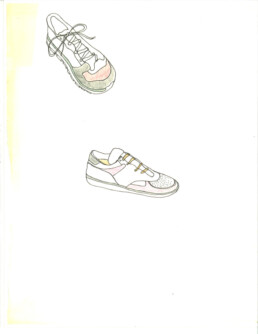The Lost Art of Ironing
by Jane Gibson
In 1951, Santa brought my first ironing board. Standing twenty-four inches tall on folding red metal legs, the muslin-covered board was just my size. The red metal iron’s black cloth-covered cord coiled gracefully at its base. Forget the doll, forget the other presents. I plugged in my iron, held my breath, and touched tentative fingertips to the shiny flat surface. Not hot enough to burn tender flesh, but hot enough to smooth a wrinkled doll dress. I was ecstatic. For weeks, my new doll lay in naked abandon as I repeatedly washed, dried, and ironed her tiny garments.
My iron and board eventually migrated to the back of a closet and then disappeared, along with the lonely Old Maid card and the fruitcake tin of broken crayons.
Embedded in my mind’s ear was the thunk-gurgle-splat of a water-filled pop bottle with its aluminum-and-cork sprinkler, shaken over a garment. Mama would put two napkins or handkerchiefs on the kitchen counter, give a couple of shakes, and repeat, until she had a stack of damp cloth pancakes. I begged her to let me sprinkle, please, please.
The moist bundle was folded in half, rolled, and plunked into a laundry basket. Shirts, blouses, and pillowcases soon followed. Moisture wicked into the fabric, marinating the mass to uniform dampness.
The full basket huddled under a tea towel and squatted on top of the deep freeze until morning, when the ironing had to be done, lest the dreaded black dots of mildew appeared. Those would demand the entire load be rewashed, re-dried, and re-sprinkled.
Mama decided I could sprinkle and iron when I was about eleven. I began with napkins, handkerchiefs, and pillowcases. “Flatwork,” my grandmother called it. Ah, but it entailed more than the name implied.
Pillowcases were ironed, folded end-to-end twice, ironed, and folded again in thirds. Daddy’s handkerchiefs folded toward me twice, edges creased with a swath of the hot iron, folded right-to-left, creased, then folded once again. Violá. A dapper look for his pocket. Everyday napkins folded once forward and once to the side. Company dinner napkins—huge squares of damask—were folded and creased into five inches of shiny elegance.
By the time I mastered flatwork and ironed three napkins at a time, Daddy bought Mama an IronRite Mangle. The name alone made me shudder. Set into a metal table, the machine resembled the top half of an old-fashioned clothes wringer, only larger and electric. The heating element was protected by a guard. Mama sat at the mangle next to the freezer and fed flatwork between the heated padded rollers. I wasn’t allowed to use the machine; I might get my fingers caught.
Mama didn’t like the mangle result on shirts and blouses, and continued hand-ironing them, suggesting I learn to iron them as well.
Shirts and blouses elevated my ironing education. Inside yoke, wrong side of collar, right side of collar, sleeves, left front, back and yoke, right front—swing your partner, do-si-do! Mama decided I could handle the mangle, and I gave thanks she didn’t iron sheets and pajamas.
The early ‘60s brought Dacron and spray starch. The ironing load dropped to shirts and an occasional tailored blouse. Daddy hired an “ironing lady” to come every Tuesday and do the shirts that he and my brother needed for the week.
Steam irons eliminated the damp bushel on Mama’s freezer, but she still had a small roll of sprinkled napkins and handkerchiefs in a tea towel. The mangle disappeared while I was away at college.
Today, napkins and pillowcases are folded right out of the dryer. The damask napkins are pressed for holidays. I touch up collars and hang-wrinkles, and iron the occasional white blouse for myself.
We send my husband’s shirts to the cleaners for heavy starch. I taught both daughters to iron, leaving no excuse for not looking presentable. One recently mentioned she needed to get a new iron. The other said she didn’t have anything to wear unless she ironed something. So I guess the art isn’t completely lost. It’s just wandering around waiting to be used.
I looked up my little iron and board on eBay. I should have kept it.
It’s a collectible. I could sell it to pay the cleaners.

